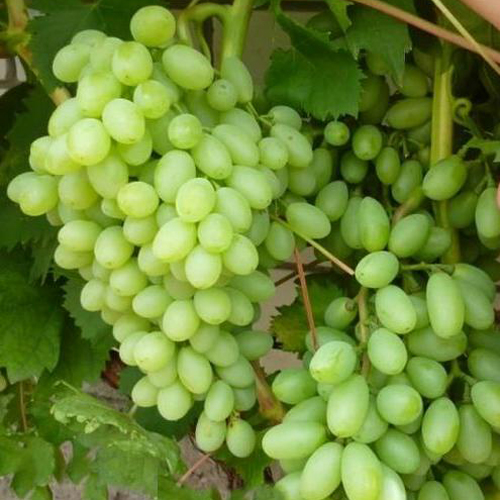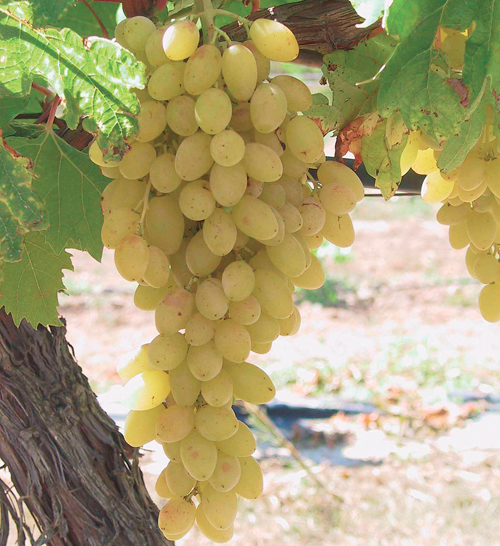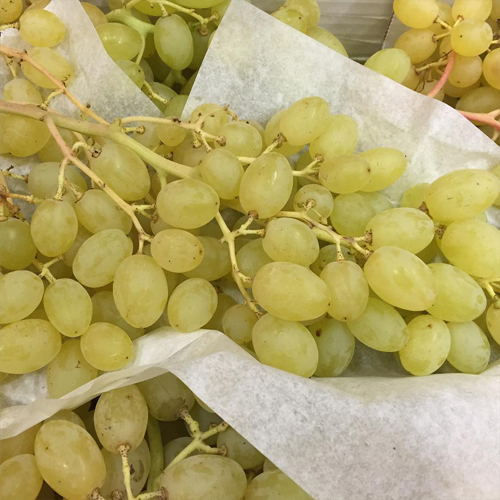Grape variety Century
Centennial seedless grapes appeared relatively recently in our country, but has already gained wide popularity among numerous amateur winegrowers. The variety is native to the United States, where it was obtained by a famous scientist in this field - Professor of the Department of Viticulture and Oenology at the University of California at Davis, Harold Olmo (Dr. Harold Olmo). The outstanding researcher lived for 97 years, and during his long life he became the author of more than 30 grape varieties.
Our hero was born as a result of complex hybridization, during which a representative of the noble European species Vitis vinifera was crossed with a hybrid Q25-6, whose parents, in turn, were the local Emperor raisin and Italian Pirovano 75 (Muscat sultanina).

Hybridization was carried out in 1966 at the university experimental agricultural station. Over the next 14 years, hybrid seeds were sown in the ground, cultivated, and then selection of promising grape seedlings and strict variety testing. After successfully passing which, the novelty was officially recognized as a variety and included in the corresponding state register. By now, in addition to the United States, our hero is allowed to cultivate in many European countries, including France, Spain, Italy and Portugal, famous for the traditions of high-quality viticulture.
In the arsenal of domestic winegrowers, raisins of the Century began to appear for the first time since the late 2000s, but in recent years, thanks to the high interest in it, they have spread quite widely, having ceased to be an exotic rarity. Those who happened to acquire it on their plots do not get tired of praising it for its visual appeal, excellent gastronomic properties of seedless berries and high yield. At the same time, it is not devoid of disadvantages, which include the tendency to shedding berries when overripe, low transportability and poor suitability for harvest storage, very moderate frost resistance of the bushes.
Despite such inconsistency, the variety remains in demand and confidently expands the geography of its growth due to more and more sincere admirers.
Agrobiological characteristics
The vigor of the vines is very high. The crown of a young shoot is half-open, slightly pubescent, the axis of the shoot is bright green, young leaves have a bronze tint. The formed leaves are very decoratively cut, large, rounded or slightly elongated in length, three-, five-, and sometimes seven-lobed, with a deep degree of dissection. The surface of the leaves of the Century is slightly wrinkled, the color of the leaf blade is green, often with anthocyanin pigmentation of the veins; the reverse side is characterized by a very weak cobweb-bristly pubescence. The upper lateral notches are deep, closed, with an oval or ovoid lumen. The lower notches are much shallower in depth, they are found both open with parallel sides and a rounded or pointed bottom, and closed with a gap similar to the upper notches. The petiole notch can also be open lyre-shaped or closed with a rounded light. Petioles are long, usually reddish in color. The teeth along the perimeter of the leaf blade are large, compared with the base, elongated in length, have smooth edges and pointed tops. The flowers of the variety are bisexual, demonstrate good pollen fertility, due to which they are perfectly fertilized. The brushes do not suffer from excessive looseness and sparseness, and the ovary is not pea. Annual shoots grow with rather short internodes, ripen on time and to a considerable length. The color of the ripe vine is yellowish brown.

Bunches of grapes are large, weighing 400-600 grams, with the use of special measures they grow up to one and a half kilograms.The shape of the hands of the Century is mostly conical, the density is medium. Grapes in clusters that are not too knocked down do not deform and do not damage each other; moreover, they differ in excellent alignment due to good pollination of the inflorescences. The comb is of medium length, rather strong, green in color with a slight reddish tinge at the base. Berries of medium and large size, up to 30 mm long, 15-17 mm in diameter, oval or slightly cylindrical in shape, yellow-green in color, weighing 4-6 grams. The pulp is firm, slightly crunchy, very pleasant, light taste with a noticeable nutmeg aroma. The juice squeezed from the berries is colorless, does not differ in high sugar content, but it does not acidify either due to its harmonious ratio with acid. At the time of the onset of removable maturity, the content of glucose and fructose is 13-14 g / 100 ml, titratable acids - 5-6 g / l. The skin of the berries is very thin, bursting when eaten and easy to chew. The variety is seedless, only in some grapes can there be slight rudiments of seeds. This circumstance significantly improves the gastronomic properties of grapes, which is confirmed by numerous lovers of this variety. Even among other popular raisins, according to tasting ratings, it is often put one step higher.
The harvest of the Century is mostly used for fresh consumption. Due to the lack of seeds, it is very much appreciated by winegrowers who grow it both for themselves and for sale. In the market, such varieties are traditionally in high demand and demonstrate better profitability due to their higher price. Berries can be used for drying without problems, although in this form the raisins will be inferior to the taste of sweeter varieties. Grapes can be successfully used in confectionery production, as well as in home canning, where delicious and aromatic juices, compotes, preserves and jams are obtained from it. It is poorly suited for long-distance transportation due to insufficiently strong attachment of berries to the ridge. Under mechanical stress during transportation, they may shatter. It is stored for a short time, and only when optimal conditions are created for this. A thin skin does not contribute to good keeping quality, and the color of the berries quickly deteriorates, instead of a pleasant yellowish color, a brown tint appears.

Ripening occurs in the early to mid-term. The growing season from the moment the buds open until the first bunches are ready for harvesting is 120-130 days. Depending on the latitude of growth, harvesting of grapes can begin in mid-August, or at a later date. The sum of active temperatures required by the Century for the onset of removable maturity is 2600-2700 ° C. This allows the cultivar to be cultivated outside of the traditional viticulture zones. It is guaranteed to be able to ripen in the Central Black Earth Region of Russia, throughout Ukraine and in the south of Belarus. The only limiting factor is its low frost resistance (-21 ° C). However, we will correct this moment by carefully warming the vines for the winter.
The yield is very high. Well-developed adult bushes are capable of "pulling" up to 20 kilograms of bunches without signs of overload. But in order to achieve such indicators, the winegrower will have to study the specifics of the variety and take measures to overcome the rather low fruitfulness of shoots, a small number of bunches on fertile vines, and also learn agricultural techniques to increase the size of bunches and grapes. At the same time, the positive side of the coin is the absence of a tendency to overload with shoots and crops, and therefore the need for laborious procedures for their rationing. In this case, on the contrary, you should try to direct the remarkable vital energy of plants into a productive channel.
Bunches hanging on bushes do not show a tendency to cracking, are rarely damaged by gray rot, and do not get sunburn, even in direct sunlight. However, despite all this, it is not recommended to leave the crop of the Century hanging on the vine for a long time.When the berries reach a sugar content of 16% or more, they may begin to crumble. In addition, overripe bunches often lose their nutmeg aroma, which negatively affects the tasting characteristics.
During ripening, special attention must be paid to protecting the grapes from wasps, which actively attack berries with a thin skin. The best option would be to place the bunches in individual protective bags, but with a large number of bushes, it will be less laborious to place special traps in the vineyard, or containers with sugar syrup or fermenting compote in which insects drown en masse.

Agrotechnical features
Cultivation of the Century, although it requires a certain amount of specificity in comparison with other grape varieties, is definitely less troublesome than the cultivation of traditional Central Asian varieties of raisins. Over the years, with his example, he destroys the established stereotype about the effeminacy of seedless forms, and given the ability to grow in regions of the middle lane that are unconventional even for ordinary table varieties, it can be considered a truly unique grape.
In the matter of planting, our hero does not show any particular demands on the type of soil, their mechanical composition or fertility. It grows well and bears fruit in completely different conditions, with the exception of, in principle, not suitable for viticulture, cold, damp, swampy, or vice versa - excessively dry places. It also fails in areas with a high level of groundwater or soil salinity. At the same time, it always reacts positively to the improvement of moisture supply and the level of mineral nutrition, due to which regular watering and fertilizing respond with an increase in yield. In climatic conditions limited by the amount of heat, where there is a risk of insufficient ripening of grapes, the bushes of the Century are planted in the southern walls, because the sum of active temperatures there is slightly higher than in open areas.
The cuttings root very well, often the sections of the vine are planted in a permanent place without germination, where they take root well, and already in the first year they give a good one-year growth. However, cultivation on one's own roots is possible only in areas free from the malicious soil pest - root phylloxera. In zones of infection, it requires planting seedlings on phylloxera-resistant rootstocks, or re-grafting of already growing bushes of other forms. The feeding area of vigorous plants should be significant so that neighboring bushes do not oppress each other. For the Century, this figure should not be less than 4.5-5 square meters.
The variety is characterized by low resistance to frost, which is why it is almost universally grown with shelter for the winter. To do this, the grapes are formed in such a way that the annual removal of the vine from the trellis does not lead to injury, and therefore the most popular schemes are squat formations like Guyot, an inclined cordon or a multi-arm fan. The latter is the most popular among domestic winegrowers. Shelter is most often made with earth, but in frost-prone regions this is not enough, which is why full-fledged insulation with light organic materials is required there - spruce branches, needle holders, wood shavings, straw or reeds, followed by protection from melt moisture using film, roofing material or wooden shields ... In the very south, with relatively mild winters, the laborious procedure of covering the bushes entirely can be facilitated by trying to apply a semi-covering scheme. In this case, the main part of the plant is formed as a non-covering standard layer, and only a small reserve lightweight layer is insulated, which serves as a guarantee of quick recovery of the aboveground part of the plants after rare atypically harsh winters. The presence of a powerful skeleton in this case will have a beneficial effect on the large-fruited and yield of the bushes in general.
Pruning a fruitful vineyard and carrying out green operations during the growing season, the variety has its own characteristics.In particular, when shortening fruit arrows, it is necessary to bear in mind the low fertility of the first 5-6 eyes of grapes, which requires a long pruning of 10-12 buds. In general, the optimal load on the Century bush is 40-45 eyes. After the start of the growth of the shoots, the weak and sterile ones are removed, but the number of brushes on the fertile vines does not need to be regulated. There is no need to remove stepchildren due to their insignificant development.
In order to increase the size of bunches and berries, it is recommended to thin out young grapes in the cluster, as well as to carry out a ringing procedure, in which part of the bark on the shoot is removed to restrain the downward flow of plastic substances, and direct them to fruit development. Also, good results are shown by the use of the growth stimulant Gibberellin at the stage of the grape protrusion of flower stalks and in the phase of "small peas". You should not only use high concentrations, because already at 50 mg / l the berries noticeably lengthen when ripe, thereby increasing their weight compared to the standard and acquiring a more attractive appearance.
Information about the resistance of our hero to diseases is rather contradictory. Some growers claim that the variety is highly resistant to them, while others still note cases of mildew and powdery mildew, in connection with which they declare the need for a serious fight against them. Under these conditions, it can be recommended to carry out mandatory preventive treatments only during the period of the greatest harmfulness of fungal pathogens before and after the flowering of grapes, and in the future to carry out constant monitoring and point-to-point response to single outbreaks of pathogenic microorganisms. You should not neglect the instructions for the chemicals used and be sure to stop using them before harvesting in accordance with the specified waiting period.
During the ripening period it is recommended to lighten the bunches. The berries of this variety are not prone to sunburn, so good lighting allows them to acquire an attractive yellow color. But you should not overexpose the harvest on the bushes, because it threatens to shedding grapes from overripe clusters. Century demonstrates high gastronomic properties of raisins even at early harvest, and the lengthening of the growing season does not bring any advantages.








